Boeing XCH-62 Heavy Lift Helicopter (HLH) Parts
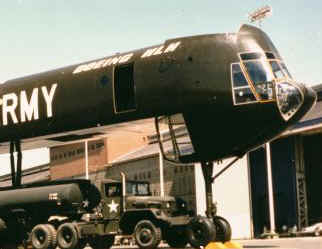 |
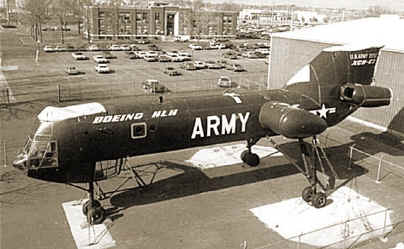 |
|
| In 2008 The Helicopter Museum (UK)
took delivery
of parts which were recovered from the Boeing XCH-62 Heavy Lift Helicopter (HLH),
cancelled as a project in 1975 and eventually scrapped at the Fort
Rucker Army Aviation Museum, in Alabama, in October 2005. This sole
prototype had deteriorated badly due, largely, to prolonged open air
storage, and had become a hazard which could have disintegrated if any
attempt to move it had been made. Helicopter Museum Chairman Elfan Ap Rees and US Army Aviation Museum director Steve Maxham were able to save some key components, including both legs of the 5.5 metre (18 feet) long main landing gear and the nose gear, all complete with wheels. These are now on display at Weston-super-Mare's Helicopter Museum. |
||
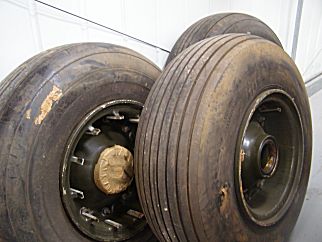 |
The XCH-62 prototype was a
tandem-rotor helicopter powered by three Allison
XT701-AD-700 turboshafts, rated at 8000hp each. The diameter of each
four-bladed rotor was 28 metres (92 feet). The crew compartment was
designed to accommodate a pilot, co-pilot, aft-facing load-controlling
crewman and a flight engineer.
Aft of the crew compartment a short section of the slim fuselage could accommodate 12 troops. The centre fuselage housed two cargo handling hoists. The aft fuselage and pylon area contained the gearboxes and engines. Stub wings contained fuel tanks and also supported the main struts of the fixed tricycle landing gear. The airframe was to be constructed entirely of bonded aluminium honeycomb panels in sizes up to 1.22 metres x 9.76 metres (4ft x 32 ft). |
|
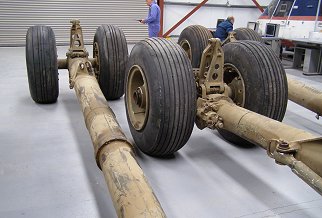 |
The HLH tricycle landing gear was designed to
have
dual wheels on each leg, differential braking on the main gear only and
power steering on the nose wheels. A main fuselage-to-ground clearance of
4.27 metres (14
feet) was provided, although the crew compartment-to-ground clearance
was down to 2.9 metres (9.5 feet). The nose gear was re-designed to provide a breakaway
path for the nose wheel strut, away from the crew compartment, to improve
crash survivability. Conventional materials were used throughout the
landing gear structure, rather
than advanced composites, to minimise costs. The Museum received all three legs, each with its pair of wheels, plus four spare wheels, as shown above left. |
|
| Shipment of the parts was organised and sponsored jointly by manufacturer Boeing, and Columbia Helicopters, a world leader in civil heavy-lift helicopter operations, with support from The Museums, Libraries and Archives Council's PRISM fund (UK) and Avia Press Associates, publishers of 'Helicopter International' & 'HeliData News'. | ||
| '...destroy
a piece of history like that.. WHY ?'
'...would have been a money-pit to save.' 'Disgrace !' 'A piece of history lost forever !' '..the guy that approved this is way '..ashamed to be an ex-army pilot.' 'Very sad and stupid..' 'They couldn't move it and they couldn't fix it, what else was left ?' |
 |
|
"Lost Forever !"The scrapping of the XCH-62 at Fort Rucker (above right), in 2005, caused widespread outrage among enthusiasts, engineers and historians as a deluge of controversy (excerpts above left) filled the internet forums and chat-rooms. However, the reasons which emerged for the destruction of the machine, showed that the resources which would have had to be devoted to its preservation would be better employed on other exhibits.The Army Museum director, Steve Maxham, said:- |
||
The History |
||||
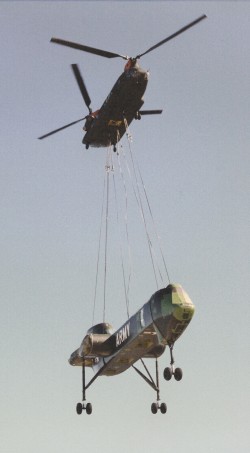 |
The US Department
of Defense awarded a contract to Boeing Vertol, Philadelphia, Pennsylvania,
in July 1971, to develop components for Heavy Lift Helicopters. These
components included rotor blades, rotor drive systems, flight control
systems and cargo handling. In January 1973, when the component designs were complete and fabrication under way, a contract was awarded to Boeing Vertol for the construction of one prototype Heavy Lift Helicopter with a 22.5 ton exterior payload, designated XCH-62, serial number 73-22012. The prototype programme involved the design and manufacture of landing gear, an aluminium honeycomb airframe and advanced technology sub-systems, including fly-by-wire control, not specified in the initial contract. Mock-ups were constructed of the cockpit, forward crew compartment and aft pylon structures. However, in August 1975, the programme was terminated when Congress declined to provide further funding. Boeing later reported that construction of the prototype had been 90% complete and that approximately three months of final assembly and checkouts remained to be done before installation of the aircraft in a tie-down rig for pre-flight testing. |
|||
Another report, published in 1987, stated that the HLH had required a transmission combiner drive train capability that, in respect of torque, would double existing limits of aircraft experience. Gearing designed to the contemporary standards proved inadequate during tests in the mid-1970s. Improved methods of calculating and measuring gear stress levels had been developed. Advanced lubrication and oil cooling with the use of selected harder steels, had eventually resulted in a drive train which would have satisfied the requirements of the HLH. |
||||
| The incomplete XCH-62 was mothballed but pulled out of storage in 1983, when the Army and NASA proposed collaboration to finish the aircraft for experimental flights but Congress again refused to fund the project. The XCH-62 remained in storage until 1987 when it was decided that it should be placed in the US Army Aviation Museum at Fort Rucker, Alabama. It was transported, by barge, from Philadelphia down the eastern seaboard to Mobile, on the Gulf of Mexico, and then airlifted, by a CH-47C Chinook, to the Army's Museum. | ||||